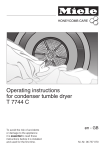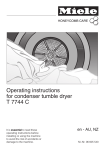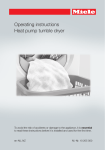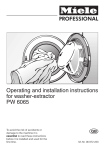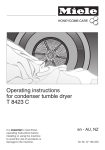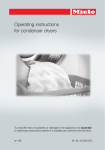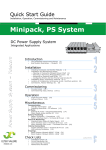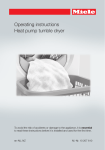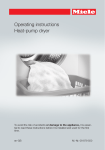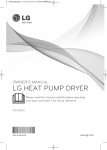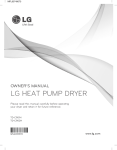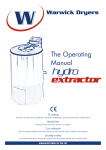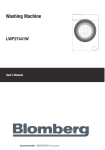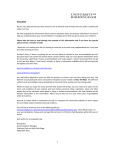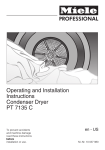Download PT 7136 user manual - First Choice Marshalls
Transcript
Operating and installation instructions
for vented tumble dryer
PT 7136 Vario
To avoid the risk of accidents or
damage to the machine, it is
essential to read these instructions
before it is installed, commissioned
and used for the first time.
en - GB
M.-Nr. 09 755 980
Caring for the environment
Disposing of the packing
material
The transport and protective packing
has been selected from materials which
are environmentally friendly for disposal
and should be recycled.
Ensure that any plastic wrappings,
bags, etc are disposed of safely and
kept out of the reach of babies and
young children. Danger of suffocation.
Disposal of your old machine
Electrical and electronic machines
often contain materials which, if
handled or disposed of incorrectly
could be potentially hazardous to
human health and to the environment.
They are, however, essential for the
correct functioning of your machine.
Please do not therefore dispose it with
your household waste.
Please dispose of it at your local
community waste recycling centre or
contact your dealer for advice. Ensure
that it presents no danger to children
while being stored for disposal.
2
Energy saving tips
To avoid unnecessarily long drying
times and high consumption of energy:
– Make sure that your laundry is
thoroughly spun before drying.
The higher the spin, the greater the
savings that can be made in energy
and time during drying.
– Load according to the optimum
amount of laundry recommended for
the programme being used.
Underloading is uneconomical.
Overloading gives a poorer quality of
drying, and may cause unnecessary
creasing.
– Make sure the room in which the
dryer is located is well ventilated.
– Remove the fluff from the filter when
necessary (see "Cleaning and Care").
– Check all parts of the ventilation
system on a regular basis, and
remove any build-up of fluff etc.
– The vent ducting should be as short,
straight and smooth as possible to
minimise any resistance to the air
throughflow.
Contents
Caring for the environment . . . . . . . . . . . . . . . . . . . . . . . . . . . . . . . . . . . . . . . . . . 2
Warning and Safety instructions . . . . . . . . . . . . . . . . . . . . . . . . . . . . . . . . . . . . . 5
Operating the tumble dryer . . . . . . . . . . . . . . . . . . . . . . . . . . . . . . . . . . . . . . . . . 16
Control panel . . . . . . . . . . . . . . . . . . . . . . . . . . . . . . . . . . . . . . . . . . . . . . . . . . . . . 16
Before using for the first time . . . . . . . . . . . . . . . . . . . . . . . . . . . . . . . . . . . . . . . . . 16
Display . . . . . . . . . . . . . . . . . . . . . . . . . . . . . . . . . . . . . . . . . . . . . . . . . . . . . . . . . . 17
Operating the tumble dryer in Laundrette mode . . . . . . . . . . . . . . . . . . . . . . . . . . 19
Notes and tips on laundry care . . . . . . . . . . . . . . . . . . . . . . . . . . . . . . . . . . . . . 20
1. Sort the laundry . . . . . . . . . . . . . . . . . . . . . . . . . . . . . . . . . . . . . . . . . . . . . . . . . 20
2. Load the tumble dryer . . . . . . . . . . . . . . . . . . . . . . . . . . . . . . . . . . . . . . . . . . . . 21
3. Select a programme . . . . . . . . . . . . . . . . . . . . . . . . . . . . . . . . . . . . . . . . . . . . . 21
Short instructions . . . . . . . . . . . . . . . . . . . . . . . . . . . . . . . . . . . . . . . . . . . . . . . . 22
Selecting a programme . . . . . . . . . . . . . . . . . . . . . . . . . . . . . . . . . . . . . . . . . . . . 26
Selecting/changing a programme . . . . . . . . . . . . . . . . . . . . . . . . . . . . . . . . . . . . . 26
Low temperature . . . . . . . . . . . . . . . . . . . . . . . . . . . . . . . . . . . . . . . . . . . . . . . . . . 28
Saving a favourite programme . . . . . . . . . . . . . . . . . . . . . . . . . . . . . . . . . . . . . . . 28
Timer . . . . . . . . . . . . . . . . . . . . . . . . . . . . . . . . . . . . . . . . . . . . . . . . . . . . . . . . . . . 29
Changing the programme sequence . . . . . . . . . . . . . . . . . . . . . . . . . . . . . . . . . 30
Payment system. . . . . . . . . . . . . . . . . . . . . . . . . . . . . . . . . . . . . . . . . . . . . . . . . . . 30
Once a programme has started . . . . . . . . . . . . . . . . . . . . . . . . . . . . . . . . . . . . . . 30
- changing the programme. . . . . . . . . . . . . . . . . . . . . . . . . . . . . . . . . . . . . . . . 30
- cancelling the programme . . . . . . . . . . . . . . . . . . . . . . . . . . . . . . . . . . . . . . . 30
Adding or removing laundry after a programme has started . . . . . . . . . . . . . . . . 30
Power cut . . . . . . . . . . . . . . . . . . . . . . . . . . . . . . . . . . . . . . . . . . . . . . . . . . . . . . . . 30
Time remaining . . . . . . . . . . . . . . . . . . . . . . . . . . . . . . . . . . . . . . . . . . . . . . . . . . . 30
Cleaning and care . . . . . . . . . . . . . . . . . . . . . . . . . . . . . . . . . . . . . . . . . . . . . . . . 31
Cleaning the fluff filter . . . . . . . . . . . . . . . . . . . . . . . . . . . . . . . . . . . . . . . . . . . . . . 31
Removing the filter . . . . . . . . . . . . . . . . . . . . . . . . . . . . . . . . . . . . . . . . . . . . . . 31
Taking the filter apart . . . . . . . . . . . . . . . . . . . . . . . . . . . . . . . . . . . . . . . . . . . . 31
Cleaning the filter whilst dry . . . . . . . . . . . . . . . . . . . . . . . . . . . . . . . . . . . . . . . 32
Cleaning the cartridge filter with water . . . . . . . . . . . . . . . . . . . . . . . . . . . . . . . 32
Cleaning the filter housing . . . . . . . . . . . . . . . . . . . . . . . . . . . . . . . . . . . . . . . . 32
Replacing the filter . . . . . . . . . . . . . . . . . . . . . . . . . . . . . . . . . . . . . . . . . . . . . . 33
Cleaning the tumble dryer . . . . . . . . . . . . . . . . . . . . . . . . . . . . . . . . . . . . . . . . . . . 33
3
Contents
Problem solving guide . . . . . . . . . . . . . . . . . . . . . . . . . . . . . . . . . . . . . . . . . . . . 34
Problem solving guide . . . . . . . . . . . . . . . . . . . . . . . . . . . . . . . . . . . . . . . . . . . . . . 34
Check and fault messages in the display . . . . . . . . . . . . . . . . . . . . . . . . . . . . . . . 34
An unsatisfactory drying result . . . . . . . . . . . . . . . . . . . . . . . . . . . . . . . . . . . . . . . 36
Other problems . . . . . . . . . . . . . . . . . . . . . . . . . . . . . . . . . . . . . . . . . . . . . . . . . . . 37
Changing the lamp . . . . . . . . . . . . . . . . . . . . . . . . . . . . . . . . . . . . . . . . . . . . . . . . 40
After sales service . . . . . . . . . . . . . . . . . . . . . . . . . . . . . . . . . . . . . . . . . . . . . . . . 41
Repairs. . . . . . . . . . . . . . . . . . . . . . . . . . . . . . . . . . . . . . . . . . . . . . . . . . . . . . . . . . 41
PC / Optical interface. . . . . . . . . . . . . . . . . . . . . . . . . . . . . . . . . . . . . . . . . . . . . . . 41
Optional accessories . . . . . . . . . . . . . . . . . . . . . . . . . . . . . . . . . . . . . . . . . . . . . . . 41
Installation and connection . . . . . . . . . . . . . . . . . . . . . . . . . . . . . . . . . . . . . . . . 42
View from the front . . . . . . . . . . . . . . . . . . . . . . . . . . . . . . . . . . . . . . . . . . . . . . 42
Side view. . . . . . . . . . . . . . . . . . . . . . . . . . . . . . . . . . . . . . . . . . . . . . . . . . . . . . 43
Rear view . . . . . . . . . . . . . . . . . . . . . . . . . . . . . . . . . . . . . . . . . . . . . . . . . . . . . 43
View from above . . . . . . . . . . . . . . . . . . . . . . . . . . . . . . . . . . . . . . . . . . . . . . . . 43
Washer-dryer stack. . . . . . . . . . . . . . . . . . . . . . . . . . . . . . . . . . . . . . . . . . . . . . 43
Installing the tumble dryer . . . . . . . . . . . . . . . . . . . . . . . . . . . . . . . . . . . . . . . . . . . 44
Transporting the dryer to its installation site . . . . . . . . . . . . . . . . . . . . . . . . . . . 44
Levelling the machine. . . . . . . . . . . . . . . . . . . . . . . . . . . . . . . . . . . . . . . . . . . . 44
Securing the tumble dryer against slippage . . . . . . . . . . . . . . . . . . . . . . . . . . 45
Payment system . . . . . . . . . . . . . . . . . . . . . . . . . . . . . . . . . . . . . . . . . . . . . . . . 45
Electrical connection . . . . . . . . . . . . . . . . . . . . . . . . . . . . . . . . . . . . . . . . . . . . . . . 46
Single phase AC 230 V - country variant . . . . . . . . . . . . . . . . . . . . . . . . . . . . . 47
Installation - extraction ducting . . . . . . . . . . . . . . . . . . . . . . . . . . . . . . . . . . . . . 48
General . . . . . . . . . . . . . . . . . . . . . . . . . . . . . . . . . . . . . . . . . . . . . . . . . . . . . . . . . 48
To calculate the total duct length . . . . . . . . . . . . . . . . . . . . . . . . . . . . . . . . . . . . . 49
To calculate the total duct length . . . . . . . . . . . . . . . . . . . . . . . . . . . . . . . . . . . 49
Calculation example . . . . . . . . . . . . . . . . . . . . . . . . . . . . . . . . . . . . . . . . . . . . . 50
Installation to the rear, left or right hand side of the machine . . . . . . . . . . . . . . . . 50
Venting system with plastic piping . . . . . . . . . . . . . . . . . . . . . . . . . . . . . . . . . . . . 51
Venting system with flexible ducting . . . . . . . . . . . . . . . . . . . . . . . . . . . . . . . . . . . 52
Main venting duct . . . . . . . . . . . . . . . . . . . . . . . . . . . . . . . . . . . . . . . . . . . . . . . . . 54
Technical data . . . . . . . . . . . . . . . . . . . . . . . . . . . . . . . . . . . . . . . . . . . . . . . . . . . 55
4
Warning and Safety instructions
~ It is essential to read these instructions.
This tumble dryer complies with current safety requirements.
Inappropriate use can, however, lead to personal injury and
damage to property.
To avoid the risk of accidents and damage to the tumble dryer,
please read these instructions carefully before using it for the first
time. They contain important information on its safety, installation,
use and maintenance.
Keep these instructions in a safe place and ensure that they are
made available to new users. They must be made aware of these
Warning and Safety instructions.
Pass these instructions on to any future users/owners.
Correct application
~ This tumble dryer is only intended for drying fabrics which have
been washed in a water solution, and marked on the manufacturer's
care label as being suitable for tumble drying.
If using dry cleaning kits, do so at your own risk, and follow the
instructions provided on the packaging.
Any other applications may be dangerous. Miele cannot be held
liable for damage resulting from incorrect or improper use or
operation.
~ The tumble dryer is not intended for outdoor use.
5
Warning and Safety instructions
~ The tumble dryer can only be used by people with reduced
physical, sensory or mental capabilities, or lack of experience or
knowledge, if they are are supervised whilst using it or have been
shown how to use it in a safe way and recognise and understand the
consequences of incorrect use.
~ Children under 8 years of age must be kept away from the tumble
dryer unless they are constantly supervised.
~ Children 8 years and older may only use the tumble dryer
unsupervised if they have been shown how to use it in a safe way
and recognise and understand the consequences of incorrect
operation.
~ Children must not be allowed to clean or maintain the tumble
dryer unsupervised.
~ Please supervise children in the vicinity of the tumble dryer and
do not let them play with it.
Technical safety
~ Before setting up the tumble dryer, check it for any externally
visible damage.
Do not install or use a damaged tumble dryer.
~ Do not make any alterations to the tumble dryer, unless
authorised to do so by Miele.
~ Do not connect the tumble dryer to the mains electricity supply by
an extension lead. Extension leads are a fire hazard and do not
guarantee the required safety of the tumble dryer.
6
Warning and Safety instructions
~ The electrical safety of this tumble dryer can only be guaranteed
when correctly earthed. It is essential that this standard safety
requirement is met. If in any doubt, please have the electrical
installation tested by a qualified electrician. Miele cannot be held
liable for the consequences of an inadequate earthing system (e.g.
electric shock).
~ Unauthorised repairs could result in unforeseen dangers for the
user, for which Miele cannot accept liability. Repairs should only be
undertaken by a Miele authorised service technician, otherwise any
subsequent damage will not be covered by the guarantee. Ensure
current is not supplied to the tumble dryer until after maintenance or
repair work has been carried out.
~ Faulty components must only be replaced by genuine Miele
original spare parts. Only when these parts are fitted can the safety
standards of the tumble dryer be guaranteed.
~ To ensure the correct performance of the tumble dryer and to
prevent the risk of faults and fire, it is important to check it and carry
out maintenance on a regular basis.
~ The tumble dryer must be isolated from the electricity supply in
the event of a fault and during cleaning and maintenance.
Please also read the "Installation and connection" and the "Electrical
connection" sections.
~ The tumble dryer must not be used in a non-stationary location
(e.g. on a ship).
7
Warning and Safety instructions
~ Please observe the instructions in "Installation and connection"
and "Technical data".
~ The socket must be easily accessible after installation in order to
disconnect the tumble dryer from the electricity supply.
~ For hard-wired machines, the all-pole isolator provided on-site
must be easily accessible after installation in order to disconnect the
tumble dryer from the electricity supply.
~ Do not block the gap between the base of the dryer and the floor
with plinth facings, deep pile carpet etc. as this would hinder a
sufficient intake of air.
~ Make sure the dryer door can be opened without hindrance after
installation.
~ In areas which may be subject to infestation by cockroaches or
other vermin, pay particular attention to keeping the tumble dryer
and its surroundings in a clean condition at all times. Any damage
which may be caused by cockroaches or other vermin will not be
covered by the appliance guarantee.
8
Warning and Safety instructions
Correct use
~ The maximum load of dry laundry for this tumble dryer is 6.5 kg.
See the Programme chart for the maximum recommended loads in
individual programmes.
~ Do not let anyone sit or lean on the door, as this can cause the
tumble dryer to tip up. Danger of injury.
~ Always close the door after use. This way you will avoid the
danger of:
– children climbing into the dryer or hiding things in it.
– pets or other small animals climbing into it.
~ Do not use a pressure washer or hose to clean the tumble dryer.
~ Always keep the area around the tumble dryer free of dust and
fluff. Dust and dirt drawn into the tumble dryer can cause blockages.
Faults can then occur as well as the risk of fire.
9
Warning and Safety instructions
~ The tumble dryer must only be used when it is connected to a
suitable ducting system. The installation site must be adequately
ventilated.
~ The ducting must not be connected to
– a chimney or vent flue which is in use,
– or to ducting which ventilates rooms with fireplaces,
– or to chimneys being used by other appliances.
Smoke or exhaust fumes can cause poisoning.
~ Check all parts of the extraction system on a regular basis (e.g.
wall vent, external grille, bends in the ducting etc.) and make sure
they are all free of any hindrance. A build-up of fluff will prevent a
free flow of air through the system. If the dryer is to be connected to
an existing ducting system, this must be checked for suitability
beforehand.
~ Adequate ventilation is essential to avoid the danger of
asphyxia and toxic fumes where another appliance which also
uses the room air (e.g. gas, oil or coal fired heater, continuous flow
or other water heater) is installed in the same or an adjacent room.
To ensure safe operation, and to prevent gases given off by these
appliances being drawn back into the room, an underpressure of
4 Pa is the maximum permissible.
Ventilation can be maintained by:
– air inlets in the external wall which cannot be closed or blocked,
or
– by fitting a window contact switch which ensures that the
appliance can only be operated when the window is open.
To ensure safe operation of your tumble dryer and to avoid an
underpressure of 4 Pa or more, please seek professional advice.
10
Warning and Safety instructions
~ If more than one tumble dryer is being installed using a joint
ducting system, each dryer must have its own non-return flap to the
joint ducting system.
Otherwise the dryers could be damaged, endangering their
electrical safety.
~ The fluff filter must be cleaned regularly.
~ The dryer must not be used without the fluff filter in place or if the
fluff filter is damaged in any way. A damaged filter can cause
operational faults and blockages in the airways, the heating
elements and in the ducting. Fire hazard.
In the event of a damaged filter, switch the dryer off and replace the
filter with a new one.
~ Do not install the tumble dryer in a room where there is a risk of
frost occurring. At temperatures around freezing point the tumble
dryer may not be able to operate properly.
The ambient room temperature should be between +2°C and
+35°C.
11
Warning and Safety instructions
~ To prevent the risk of fire, the following textiles must not be dried
in this tumble dryer:
– items which have not been washed.
– items, such as workwear, which have not been thoroughly
cleaned and which are still soiled with grease, oil or other
deposits (such as cosmetics, lotions etc).
If items have not been thoroughly cleaned there is a danger that
these might self-ignite when heated, even after they have been
removed from the dryer at the end of the programme.
– items (e.g. mops and floor cloths) which have been treated with
inflammable cleaning agents or which contain residues of
acetone, alcohol, benzine, petrol, kerosene, stain remover,
turpentine, wax, wax remover or other chemicals.
– items which have been splashed with hair lacquer, hair spray, nail
varnish remover or similar substances.
When washing such heavily soiled items ensure that you use
sufficient detergent and select a high temperature. If in doubt,
wash the items several times.
~ Remove all items such as lighters and matches from pockets.
~ Warning: Do not switch the tumble dryer off before the drying
programme has finished. If this is done, the laundry must be hung
up or spread out to cool it down.
12
Warning and Safety instructions
~ Danger.
This tumble dryer must not be connected to a controllable socket
(e.g. a timer switch or a peak load shut-off device).
If the dryer programme were to be interrupted before the end of the
cooling down phase, the laundry could self-combust.
~ To prevent the risk of fire, the following must not be tumble dried:
– items which have been cleaned using chemicals (e.g.
professional dry-cleaning agents).
– fabrics which contain a large proportion of rubber, foam rubber or
rubber-like materials. For example, products made from latex
foam rubber, shower caps, waterproof textiles, rubberised articles
and items of clothing and pillows with foam rubber filling.
– damaged items which contain padding or fillings (e.g. pillows,
jackets). When damaged, the filling can get out with the risk of
igniting in the dryer.
~ In many programmes, the heating phase is followed by a cooling
down phase to ensure that the items are not too hot to handle when
you remove them (this also avoids the danger of the laundry
self-igniting). The programme is not finished until the cooling down
phase has been completed.
As soon as the programme has finished, remove all laundry from the
drum.
~ Fabric conditioner and similar products must be used according
to the instructions on the manufacturer's packaging.
13
Warning and Safety instructions
~ Benzine, petrol, paraffin or any easily flammable liquid must not
be stored or used near the tumble dryer. Danger of fire and
explosion.
~ Do not allow air contaminated with chlorine, fluorine or other
vapours containing solvents to get into the tumble dryer. Fire
hazard.
~ For tumble dryers with stainless steel surfaces:
The stainless steel surfaces must not come into contact with liquid
cleaning and disinfecting agents which contain chlorine or sodium
hypochlorite. These agents can have a corrosive effect on stainless
steel.
Aggressive vapours containing chlorine can also be corrosive.
Do not, therefore, store containers of these agents near the tumble
dryer.
14
Warning and Safety instructions
Accessories
~ Only use genuine Miele original spare parts and accessories with
this tumble dryer.
If non-Miele parts are used, guarantee, performance and product
liability claims may be invalidated.
~ A Miele tumble dryer can be stacked on top of a Miele washing
machine using the appropriate stacking kit (available as an optional
accessory). Please make sure you order the correct one for the
Miele tumble dryer and Miele washing machine.
~ If installing the machine on a Miele plinth, (available as an
optional accessory), please make sure you order the correct one for
this tumble dryer.
Miele cannot be held liable for damage caused by
non-compliance with these Warning and Safety instructions.
15
Operating the tumble dryer
Control panel
a Display
After the machine has been switched
on, the display lights up.
As soon as the dryer is ready to use,
the Entry menu appears in the
display.
b Short cut buttons (keys)
For selecting an individual drying
programme quickly. These buttons
can be programmed to select your
own favourite drying programmes.
c Start button
The indicator light flashes when a
programme can be started and lights
up when the programme starts.
d PC/Optical interface
This is used by Miele service
technicians during servicing work for
testing purposes.
e Multi-function selector
This is used to select menu options
(by turning it) and to confirm your
selection (by pressing it).
16
f On/Off button K
For switching the dryer on and off.
To save energy the dryer will switch
off automatically 15 minutes after the
end of the programme/anti-crease
phase or 15 minutes after the dryer is
switched on if it no other selection is
made.
g a button
Opens the machine door
independently of the electricity
supply.
Before using for the first time
Before using the machine for the first
time, ensure that it is correctly
installed and connected. See
"Installation and connection".
Commission the machine as described
in the separate booklet
"Commissioning, Programme chart and
Settings" supplied with the machine.
Operating the tumble dryer
Display
Entry menu
1
Cottons
Programme selection ...
2
Minimum iron
Settings F ...
3
Woollens handcare
4
Smoothing
10:00
When the tumble dryer is switched on, the entry menu (with
four favourite programmes listed) appears with Programme
selection highlighted.
Multi-function selector
Turning the multi-function selector moves the highlighting to
the next option.
Pressing the multi-function selector selects the highlighted
option.
Shortcut buttons
Pressing a shortcut button selects one of the four favourite
programmes shown on the left of the display.
If you wish to change the programmes shown in this list you
can do so (see "Selecting a programme - Saving a favourite
programme" for more information).
The shortcut buttons have different functions in the other
menus. Where this is the case, an arrow H will appear in the
display above the shortcut button, together with a description
of its function .
Programme selection
There are two ways of selecting a programme:
– Option 1: Select the Programme selection menu in the
display and confirm your selection by pressing the
multi-function selector.
– Option 2: Press shortcut button D E F or G . This
will automatically take you into the main menu for that
programme.
17
Operating the tumble dryer
Programme selection menu
Programme
selection
Back A
Cottons
Minimum iron
Delicates
H
You can use the multi-function selector to select any
programme. The highlighting will move up or down
depending on the direction the multi-function selector is
turned in.
The HV arrows on the right of the display, indicate further
options.
Pressing the multi-function selector takes you to the main
menu of the programme selected.
Drying programme main menu
Cottons
Normal
Duration 0:50 h
Low temp.
Timer Y
Save
Back A
H
H
H
H
^ Turn the multi-function selector to highlight either the
"Drying level" or the "Programme".
– Pressing the multi-function selector selects the highlighted
option and opens the relevant sub-menu.
– Low temperature and Timer can be selected by pressing
shortcut buttons D or E.
– To go back to the entry menu press shortcut button G.
Alternatively, you can also highlight and confirm all options by
just using the multi-function selector.
Settings menu J
The Settings menu J is used to alter the tumble dryer's
electronics to suit different requirements. See the separate
booklet "Commissioning, Programme chart and Settings" for
further information.
18
Operating the tumble dryer
Operating the tumble dryer in Laundrette mode
The entry menu will vary depending on the Controls setting
selected.
^ The dryer is operated either with shortcut buttons D,
E, F, G or the multi-function selector.
WS-shortcut keys, basic
1
Cottons
Normal+
2
Minimum iron
Normal
3
Woollens handcare
4
Cool air
4 programmes are available to choose from. To specify which
programmes are available go to the Settings/supervisor level
menu.
WS-shortcut keys + Logo
M
PROFESSIONAL
##
H
P
H
#
H
More
H
12 drying levels and timed programmes are available to
choose from. To specify which programmes are available go
to the Settings/supervisor level menu.
WS-shortcut keys, ex/int time
M
PROFESSIONAL
Q
H
R
H
S
H
T
H
4 timed programmes with different temperature levels are
available to choose from. To specify which programmes are
available, go to the Settings/supervisor level menu.
19
Notes and tips on laundry care
1. Sort the laundry
Garment care label symbols
Drying
q
Normal/higher temperature
r
Reduced temperature:
Select Low temperature
(for delicate textiles)
s
Do not tumble dry
Ironing
I
Very hot
H
Hot
G
Warm
J
Do not iron
Before drying
– Wash heavily soiled items very
thoroughly, ensuring that you use
sufficient detergent and select a high
temperature. If in doubt, wash the
items several times.
– Do not put soaking wet items into the
tumble dryer Make sure that your
laundry is thoroughly spun before
drying.
The higher the spin, the greater the
savings that can be made in energy
and time during drying.
– New dark-coloured garments should
be washed and dried separately
from light-coloured garments the first
few times they are washed, to avoid
the risk of colours running and
discolouring other garments or even
the plastic components in the tumble
dryer.
Dark-coloured fibres can also settle
on light-coloured garments and vice
versa.
– Starched laundry can be dried in the
tumble dryer. To achieve the usual
finish, double the amount of starch
should be used.
– Check the seams of padded or
down-filled items to prevent the risk
of fillings coming out. These could
catch fire in the tumble dryer.
– Tie together textile belts and apron
ties to stop them getting tangled.
– Fasten duvet covers etc. to prevent
small items from being trapped
inside them. Fasten hooks and eyes
etc.
– Stitch in or remove loose underwiring
from bras.
– Leave jackets open and undo any
long zips so that textiles dry evenly.
– For an even drying result, it is
important to . . .
. . . spin,
. . . shake out,
. . . and sort items according to
fabric type, size, care label and the
drying level required.
20
Notes and tips on laundry care
2. Load the tumble dryer
,Using the tumble dryer
incorrectly could cause a fire. Read
the "Warning and Safety instructions"
before using the tumble dryer.
,Make sure that objects, e.g.
detergent dispensing balls, have
been removed from the laundry.
They could melt and cause damage
to the dryer or the laundry.
– Do not overload the drum.
Overloading can cause unnecessary
wear and tear to the laundry, give a
disappointing drying result and
cause more creasing.
– To save energy, always observe the
maximum load for each programme
(see the separate booklet
"Commissioning, Programme chart
and Settings").
– Minimum iron fabrics tend to crease
more the greater the load. This is
also the case for garments made
from very fine weave fabrics, such as
shirts or blouses.
If necessary, reduce the size of the
load for these types of fabrics.
3. Select a programme
. . . e.g. Machine iron or Hand iron if
the laundry needs further processing
after drying.
See separate booklet
"Commissioning, Programme chart
and Settlings".
– For delicate fabrics with the r care
label, select Low temperature as
well.
– Down-filled garments have linings
which have a tendency to shrink,
depending on the quality of the item.
They can be partially dried using the
Smoothing programme.
– Pure linen should only be machine
dried if specified as suitable by the
manufacturer on the care label, as
the surface of the fabric may
otherwise become rough. They can
be partially dried using the
Smoothing programme.
– Woollens and wool blends tend to
become matted and shrink if dried in
a tumble dryer. Only dry these
fabrics in a Woollens programme.
– Loopknit garments (e.g. T-shirts and
underwear) tend to shrink depending
on their quality. Do not over-dry
these textiles. When purchasing
these garments it is advisable to take
their shrinkage properties into
account.
– On many programmes, different
drying levels can be selected
depending on individual
requirements . . .
. . . e.g. Normal+ for laundry that you
want to fold and put away immediately after drying.
21
Short instructions
A Sort the laundry
,It is very important to read the
"Notes and tips on laundry care"
section before proceeding.
B Load the tumble dryer
,To avoid damaging your laundry,
when shutting the door check that
no items of laundry have become
trapped in the door opening.
^ Open the door.
^ Load the drum.
22
^ Shut the door either with a gentle
swing, or lean against it and push it
shut.
Short instructions
C Select a programme
^ Switch the dryer on by pressing the
On/Off K button.
Please note:
– If no further selection is made within
15 minutes, the dryer will switch off
automatically.
– This does not apply to machines with
a payment system.
Programme chart
– See separate booklet
"Commissioning, Programme chart
and Settings".
You can select a programme either by:
2. Selecting a programme from the
Programme selection menu (turn A
and press B).
Select Low temperature or Timer, if
required
^ Select Low temperature and/or the
Timer (Delay start time) from the
relevant sub-menu.
Coin operation/payment system
If your machine is connected to a
payment system, the amount of
payment required will appear in the
display.
1. Using the appropriate short cut
button to select one of the four
programmes listed in the display
("favourites"), or
Opening the door or cancelling the
programme after it has started may
cause a loss of credit (depending on
how the tumble dryer was set up).
23
Short instructions
D Start the programme
– Interruption to the power supply
The Start button will flash as soon as a
programme can be started.
– Time remaining
^ Press the Start button.
Programme duration/Estimated time
remaining
The Start button will now light up.
– Prog. running will appear in the
display, followed by Drying and the
programme duration.
– With sensor drying programmes, e.g.
Machine iron ... Hand iron etc., the
drying level reached will be shown in
the display later on.
Once drying is in progress, you can
press one of the short cut buttons:
– Button E Timer to call up the
estimated end time of the
programme and the current time of
day.
– Button F Save to save the current
programme as a favourite.
– Button G Cancel to cancel the
current programme.
This only applies to machines with a
payment system, if a programme can
be cancelled without the loss of
credit.
See section "Changing the programme
sequence" for further information about
the following:
– Payment system
– Changing a programme once it has
started
– Cancelling the current programme
– Adding or removing laundry after a
programme has started
24
When a programme is selected, the
estimated duration will appear in the
display. Please be aware that it is only
an estimate!
The following factors all affect the
estimated time remaining: residual
moisture content after spinning; type of
fabric; size of load; room temperature;
fluctuations in power supply.
The electronics assess conditions in the
dryer and adjust the estimated time
remaining for a more accurate reading.
Because of this, the time displayed can
alter during the course of a programme.
Before the end of a programme
In many programmes the heating
phase is followed by the cooling down
phase: Cooling down will appear in the
display. The programme is not finished
until the cooling down phase has been
completed.
Do not switch the tumble dryer off
before the end of the drying
programme.
Short instructions
E Remove the laundry when the
programme has finished
Anti-crease (if selected) and Finish will
appear in the display to indicate that
the programme has finished.
Please note:
– To avoid creasing, during the
anti-crease phase the drum will
continue to turn at intervals until the
laundry is removed.
– The dryer will switch off automatically
15 minutes after the end of a
programme/the end of the
anti-crease phase.
It is advisable to remove laundry as
soon as the programme has
finished.
Check that all items have been
removed from the drum. Anything
left in the dryer could be damaged
by overdrying when it is next used.
The drum lighting will come on when
the door is opened. It will go out a few
minutes later to save energy.
^ Switch the dryer off by pressing the
On/Off K button.
The display will go out.
^ Close the door.
Maintenance after each drying
programme
^ Please see "Cleaning and care" for
details.
^ Open the door.
^ Remove everything from the drum.
25
Selecting a programme
Selecting/changing a programme
Entry menu
1
Cottons
Programme selection ...
2
Minimum iron
Settings F ...
3
Woollens handcare
4
Smoothing
10:00
^ Press shortcut button D.
Main menu
Cottons
Normal
Duration 0:50 h
Low temp.
Timer Y
Save
Back A
H
H
H
H
^ By turning the multi-function selector you can then highlight
the following options in the display: Programme (Cottons)
or the drying level (Normal), and confirm your selection by
pressing the multi-function selector.
Depending on the option highlighted, the following will be displayed:
– Programme selection
Programme
selection
Back A
Cottons
Minimum iron
Woollens handcare
H
^ Use the multi-function selector to select the programme
you want, and confirm your selection. The main menu will
reappear.
26
Selecting a programme
Note: If you do not make a selection in the sub-menu within
approx. 20 seconds, the display will revert to the main menu.
– Programmes with drying levels
Cottons
Normal+
Drying levels from
Machine iron - Extra dry
c
^ Use the multi-function selector to select the drying level you
want, and confirm your selection.
– The display will show which drying levels can be selected
for each individual programme.
– Programmes where the time can be altered
Hot air
10:00
0:20 h
Finish:
10:20
Duration:
0:20
h
^ You can increase or decrease the duration of the
programme* using the multi-function selector.
The programme end time for the duration selected will also
appear.
* If the tumble dryer has a payment system, the maximum
duration for a programme is set during the commissioning
process under the controls option WS-shortcut keys, ex
time/int time.
– Other programmes
You cannot alter the drying level or duration for the other
programmes.
27
Selecting a programme
Low temperature
Select Low temperature for all delicate or minimum iron
fabrics with the r care label (e.g. acrylic garments).
– Delicate fabrics are dried at a lower temperature.
– The programme duration is longer.
^ Press shortcut button D Low temp.
Saving a favourite programme
You can programme the shortcut buttons to call up the four
most frequently used drying programmes. The Save option
must be activated via the Settings/Supervisor level menu
before the shortcut buttons can be programmed.
Cottons
Normal+
Low temp.
Duration 1:06 h
Low temp. B
Timer Y
Save
Back A
H
H
H
H
^ Press shortcut button F Save.
Selecting a shortcut button
Cottons
Normal+
Previous:
Cottons
Extras:
None
Save to:
1 2 3 4
Normal
Back A
^ Use the multi-function selector to select the number you
want to save the programme to, and confirm your selection.
Your settings have now been saved and the favourite
programme will appear in the entry menu.
Repeat the procedure if you want to customise other favourite
programmes, and save them to short cut buttons which have
not yet been used.
28
Timer
Depending on the Delay start setting, you can use the
Timer to set the time you wish a programme to finish or
start at, or you can delay the start of the programme.
To open the Timer sub-menu
Cottons
Normal+
Low temp.
Duration 1:06 h
Low temp. B
Timer Y
Save
Back A
H
H
H
H
^ Use shortcut key E Timer to open the Timer sub-menu.
To select a delay start time
Cottons
Normal+
Low temp.
10:00
Start time:
Finish:
10:00
11:06
^ Select the time required (in 30 minute steps) using the
multi-function selector, and confirm.
The start and finish times will now be postponed by the
time inputted. The maximum time that an automatic
programme start can be delayed by is 24 hours.
To start the timer
^ Press the Start button.
The timer will count down in minutes until the start of the
programme. If the delay start time selected is more than
one hour, the drum will turn briefly every hour to prevent
creasing.
To cancel the timer
^ Press shortcut button G Cancel.
^ The programme can now be started.
29
Changing the programme sequence
Payment system
Opening the door or cancelling the
programme after it has started may
cause a loss of credit (depending on
how the tumble dryer was set up)*.
* Either during the commissioning
process or subsequently, a Miele service technician can re-set the payment
system so that programming changes
can be made.
Once a programme has started
- changing the programme
You cannot change to another
programme once a programme has
started (this prevents unintentional
alterations).
Adding or removing laundry
after a programme has started
,The laundry, the drum and the
back of the tumble dryer all become
very hot during operation. Take care
when in the vicinity of the appliance,
when opening the door and
handling freshly dried laundry.
Danger of burning.
^ Press shortcut button G Cancel.
On some programmes, laundry will
be cooled down if a certain
temperature has been reached.
^ Only open the door once the laundry
has cooled down completely.
^ Add or remove items as required.
^ Close the door.
You will need to cancel the current
programme before you can select a
new one.
^ Select a programme.
- cancelling the programme
Power cut
^ Press shortcut button G Cancel.
– If the tumble dryer was switched off
during a programme or there has
been a power cut:
On some programmes, laundry will
be cooled down if a certain
temperature has been reached.
If shortcut button G Cancel is
pressed again, Finish appears in the
display.
^ Press the Start button.
^ Press the OK button after switching
the dryer back on and start the
programme again.
^ Open the door.
Time remaining
^ Close the door.
The time left shown in the display may
now vary from the actual drying time.
^ Immediately select the programme
you want, and then start it.
30
Cleaning and care
Cleaning the fluff filter
,The fluff filter should be checked
and cleaned regularly, but always
clean immediately if the Clean out
airways message shows in the
display.
Fluff from items being dried is collected
by a two-part cartridge fluff filter which
needs to be removed and taken apart
for cleaning.
Useful tip: You can also use a vacuum
cleaner to remove the fluff.
Removing the filter
^ Press on the right hand side of the
access panel to the filter housing to
open it.
^ Pull the filter out by the handle.
Taking the filter apart
^ Holding the filter firmly by the
handles on either side, twist the inner
filter anti-clockwise as shown (1).
^ Pull the two sections of the filter apart
as shown (2).
31
Cleaning and care
Cleaning the filter whilst dry
^ Open the door.
^ Turn the catches a on the left and
right covers until you hear them click.
^ Use your fingers or a vacuum cleaner
to remove the fluff from the two
sections of the filter.
^ Holding the catches, pull the covers
towards the middle and out as shown
b, and clean them.
Cleaning the cartridge filter with
water
If there is a great deal of compacted
fluff on either part of the filter, they can
be cleaned under hot running water.
,Dry the two sections thoroughly
before reassembling them. A damp
or wet filter could cause operational
faults when the dryer is switched on.
Cleaning the filter housing
The filter housing should be
checked regularly, and only
cleaned when there is a great deal
of fluff there.
32
^ A vacuum cleaner can be used to
remove the fluff.
Cleaning and care
^ Replace the covers in the door
opening by first inserting them at the
bottom and then pressing them into
place at the top.
^ Turn both catches shut (you will hear
them click).
The fan behind the filter can become
clogged with detergent residues and
fluff.
^ Holding the filter by the handle, push
it into its housing as far as it will go.
The handle on the inner section of the
filter can be turned to enable the filter
to be replaced and removed
comfortably.
^ Close the access panel.
Cleaning the tumble dryer
,Disconnect the tumble dryer
from the mains electricity supply.
,Do not use solvents, abrasive
cleaners, glass cleaners or
all-purpose cleaners. These could
damage plastic surfaces and other
parts.
,The tumble dryer must never be
hosed down.
^ Using a damp cloth, carefully clean
. . . any residues on the fan
. . . the fluff from around the fan
. . . the fluff from inside the access
panel. Take care not to damage the
rubber seal.
Replacing the filter
^ Reassemble the inner and outer
sections of the filter.
^ Slowly turn the inner section of the
filter clockwise until it you hear it
click.
^ Clean the housing and the control
panel with a slightly damp cloth and
a mild detergent or soapy water.
^ The drum and other stainless steel
parts can be cleaned with a suitable
proprietary stainless steel cleaner
following the manufacturer's
instructions.
^ Dry all parts with a soft cloth.
A range of Miele branded cleaning
and conditioning agents is available
to order via the Miele Spare Parts
Department or via the internet at
www.miele-shop.com.
33
Problem solving guide
Problem solving guide
With the help of the following notes minor faults in the performance of the
appliance, some of which may result from incorrect operation, can be put right
without contacting the Service Department.
,Repair work to electrical appliances should only be carried out by a
suitably qualified person in strict accordance with current local and national
safety regulations. Repairs and other work by unqualified persons could be
dangerous. The manufacturer cannot be held liable for unauthorised work.
Check and fault messages in the display
Problem
Possible cause
Remedy
1
Adjust the load
The drum is empty or
the laundry is too dry.
This is not a fault.
In some programmes, if
the drum has been
overloaded or
underloaded, the
programme will be
cancelled. This can also
happen if the items are
already dry.
Use the Hot air
programme (timed
drying) to dry individual
items.
To delete the message:
– Open the door.
;
Technical fault
A programme cannot be – Make a note of what
started while there is a
is shown in the
fault message in the
display.
display.
– Try to start the
programme again.
If restart is unsuccessful,
call Service.
A fault number (e.g.
F43) might also be
displayed.
:
34
Power failure
Programme stopped
Press OK button
– Press the OK button
The tumble dryer was
switched off during a
after switching the
programme or there has
dryer back on and
been a power cut.
start the programme
again.
Problem solving guide
Problem
E
Clean out airways
Clean the fluff filter.
Check ducting.
appears after a
while.*
E
Clean out airways
Clean the fluff filter.
Check ducting.
appears at the end
of a programme.*
E
Clean out airways
Clean the fluff filter.
Check ducting.
appears after a
programme has
been cancelled.
Possible cause
Remedy
Reminder to clean the – Clean the fluff filter.
filter.
To delete the fault message:
– Confirm with OK.
There is a blockage
– Clean the fluff filter behind
in the ducting system.
the access panel on the
right hand side underneath
the door.
– Check all possible causes
given under "The drying
process goes on too long or
even switches off."
To delete the fault message:
– Open and close the door.
The vent ducting may – If very long ducting is used,
be very long, which
then programme times will
does not constitute a
be longer and energy
fault.
consumption higher.
There is a very severe – See above.
blockage in the
To delete the fault message:
ducting system.
– Confirm with OK.
* You can adjust the setting which controls if or when the check message
appears:
See "Clean the filter" and "Clean out airways" in the "Settings/Supervisor level
menu" section in the separate booklet "Commissioning, Programme chart and
Settings".
35
Problem solving guide
An unsatisfactory drying result
Problem
The laundry is not
sufficiently dry.
Possible cause
The load consisted of
different fabrics.
Feathers are a natural
product and this is quite
normal.
Items made of synthetic Synthetic fibres tend to
fibres are charged with attract static charge.
static electricity after
drying.
Feather filled pillows
smell after drying.
There is a build-up of
fluff.
36
Fluff is principally the
result of friction when
garments are being worn
and to some extent when
they are being washed.
Machine drying hardly
causes any fluff to form
and has no appreciable
effect on the lifetime of
the fabric.
Remedy
– Finish drying using the
Hot air programme
(timed drying).
– Next time, select a
more suitable
programme (see
"Programme chart" in
the separate booklet
"Commissioning,
Programme chart and
Settings").
The smell will dissipate
after sufficient airing.
Static charge can be
reduced by adding a
fabric conditioner to the
final rinse in the washing
programme or a fabric
conditioner sheet to the
load when drying.
Fluff is collected by the
fluff filter and can be
easily removed (see
"Cleaning and care").
Problem solving guide
Other problems
Problem
The drying
process goes on
too long or even
switches off.
Possible cause
You might be asked to
clean the ducting system
again.
The fluff filter is blocked.
Remedy
Please check all possible
causes, described below.
– Remove any fluff.
The filter housing is
– Clean the filter housing.
blocked with e.g. fluff and – The cover in the door
hair.
opening can be removed to
facilitate the cleaning of the
filter housing below.
The vent ducting or the
– Check all parts of the vent
ducting system on a regular
ventilation outlet is
basis (e.g. bends in the
blocked with e.g. fluff or
hair.
ducting etc.) and clean them
if necessary.
Ventilation to the dryer is Open a door or window while
insufficient (e.g because it the tumble dryer is in operation
for increased air flow.
is installed in a room
which is too small).
The laundry has not been Make sure that your laundry is
spun sufficiently.
thoroughly spun at the
appropriate spin speed in the
washing machine.
The tumble dryer has
Do not exceed the maximum
been overloaded.
load for the programme
selected.
Metallic components, e.g. – Open zips next time.
zips, have prevented the If the problem occurs again,
dryer from registering the dry garments with long zips
correct moisture level in
using the Hot air programme
the laundry.
(timed drying).
37
Problem solving guide
Problem
Possible cause
There is a build-up of
condensed water in the
drum.
There is more than one
tumble dryer vented
together.
Power cut
38
Remedy
– The dryer must only be
connected to a joint
ducting system if a
non-return flap is in
place.
– Check the non-return
flap regularly for
damage, and replace it
if necessary.
– Once power has been restored, switch the dryer
back on with the s button.
– Press OK to confirm.
Problem solving guide
Problem
Possible cause
Remedy
The programme
does not start and
the display is dark.
There is no power to
the dryer.
– Is the dryer switched on?
– Is the door closed properly?
– Has the fuse or circuit
breaker tripped?
When the power comes back
on after a power cut, confirm
with OK and start the
programme again.
The dryer switches off
automatically after 15
minutes if no further
selection is made.
The display has
switched off
automatically to save
energy: Standby.
Switch the dryer on.
A different language
has been selected.
The flashing indicates
that a programme can
be started.
Set the language you want. The
flag symbol J will guide you.
Once the programme has been
started, the Start button stops
flashing and lights up
constantly.
– It will switch on again after
the door has been closed
and then opened.
– If the lamp needs to be
replaced, follow the
instructions in "Changing the
lamp" at the end of this
section.
The display is dark
and the Start button
is flashing slowly.
The display is in a
different language.
The Start button
light flashes when a
programme is being
selected.
The interior drum
lighting does not
come on.
The lighting switches
off automatically (to
save energy).
The display and the
multi-function selector will light
up when one of the buttons is
pressed.
39
Problem solving guide
Changing the lamp
Disconnect the tumble dryer from
the mains electricity supply.
The lamp specification and
maximum wattage is stated on the
data plate and on the lamp cover.
^ Open the door.
^ Replace the lamp.
You will find the interior lamp cover at
the top of the drum aperture.
^ To close the cover push it upwards
and press it on the left and right until
you hear it click into position.
,Ensure that it is fitted into
position securely, as any moisture
could cause a short circuit.
^ Insert a suitable tool, such as a wide
bladed screwdriver, under the side
edge of the lamp cover as illustrated.
^ Apply a little pressure and whilst
doing so turn your wrist in the
direction of the arrow to open the
cover.
The cover will open downwards.
The temperature resistant lamp should
only be ordered from your Miele dealer
or the Miele Spare Parts Department.
40
After sales service
Repairs
PC / Optical interface
In the event of any faults which you
cannot remedy yourself, or if the tumble
dryer is under guarantee, please
contact
The indicator or check light marked PC
on the fascia panel is the interface used
by Miele service technicians during
servicing work for testing purposes and
for updating the machine´s programme
data.
– your Miele Dealer
or
– the Miele Service Department (see
back cover for contact details).
When contacting the your Dealer or the
Service Department, please quote the
model and serial number of your dryer
both of which are shown on the data
plate.
Optional accessories
Optional accessories for this dryer are
available from your Miele Dealer or from
the Miele Spare Parts Department.
Please note that telephone calls may
be monitored and recorded for
training purposes.
N.B. A call-out charge will be
applied for service visits where the
problem could have been resolved
as described in these instructions.
41
Installation and connection
View from the front
a Vent ducting
b Mains connection cable
c Control panel
d Door
e Access panel to fluff filter
f Four height adjustable screw feet
g Plinth
42
h Fixing bracket (for installing on a
concrete plinth)
Installation and connection
Side view
View from above
Rear view
Washer-dryer stack
a Protruding lid (see arrows) for
holding when moving the machine
The tumble dryer can be combined with
a Miele washing machine in a
washer-dryer stack. A stacking kit is
required which can be purchased from
Miele. The stacking kit must be fitted by
a Miele authorised service technician.
b Steel plinth base (optional
accessory, available open or closed)
43
Installation and connection
Installing the tumble dryer
Levelling the machine
,Make sure the dryer door can be
opened without hindrance after
installation.
Transporting the dryer to its
installation site
The machine must be perfectly level to
ensure safe and proper operation.
When moving the dryer hold it by the lid
where it protrudes to the rear.
To manoeuvre the dryer out of its
packing case to its installation site you
will also need to hold it by the front feet.
,Ensure the tumble dryer is stable
during transportion.
^ The screw feet can be adjusted to
compensate for any unevenness in
the floor.
44
Installation and connection
,A ventilation gap of 10 mm must
be maintained between the base of
the machine and the floor. It must
not be blocked by deep pile
carpets, plinths, etc, which would
prevent a sufficient intake of cold air.
This tumble dryer is not suitable for
building under.
Securing the tumble dryer against
slippage
Payment system
The dryer can be fitted with a payment
system (optional accessory).
This must be connected and
programmed by a Miele Service
technician.
Coins/tokens must be removed from
the payment system regularly,
otherwise it will become blocked.
– Note for service technician:
,When connecting to a payment
system, the plug connector on the
push button switch (see wiring
diagram) must be disconnected
from its position ex-works and
reconnected to the position for
payment system operation.
Failure to do this can cause the
payment system to malfunction.
,Secure both front feet on the
dryer using the fixing brackets
supplied.
45
Installation and connection
Electrical connection
,All electrical work must be
carried out by a suitably qualified
and competent person in
accordance with current local and
national safety regulations (BS 7671
in the UK).
This machine is supplied with a
connection cable without a plug for
connection to a suitable connection
socket or isolator switch.
The machine must only be operated
with the voltage, frequency and fuse
rating shown on the data plate supplied
with the machine. Please ensure these
match the site mains supply.
We recommend connecting the
machine to the power supply via a
suitable plug and socket which must be
easily accessible for servicing and
maintenance work after the machine
has been installed.
For hard-wired machines, connection
must be made via a suitable mains
switch with all-pole isolation which
when in the off position ensures a 3 mm
gap between all open contacts.
For extra safety and protection we
recommend connecting the machine by
a 30 mA residual current device (RCD).
An electrical safety test must be carried
out after installation and after any service work.
The mains connection cable may only
be replaced by an original Miele spare
part.
46
,If the machine is disconnected
from the electricity supply adequate
measures must be taken to ensure
that the machine cannot be
reconnected to the electricity supply
until all work has been carried out.
,This machine can be converted
to a different voltage. Please
observe the switching instructions
given on the wiring diagram.
Conversion may only be carried out
by a Miele authorised service dealer
or Miele technician.
If the machine has been converted
the heater rating must also be
adapted.
,The machine must be
permanently connected to the
electricity supply to enable the
programme to complete and to
enable the load to cool down after
drying. For this reason, it must not
be connected to devices such as
timers which would switch it off
automatically.
WARNING
THIS MACHINE MUST BE
EARTHED
Installation and connection
Single phase AC 230 V - country
variant
This device is intended for connection
to a power supply system where the
maximum value of external phase
neutral loop impedance Zmax of
0.39 Ohms at the point of distributor
supply connection is not exceeded.
If in doubt, please ask your electrical
distributor for actual Zmax value. The
user has to ensure that this device is
connected only to a power supply
system which fulfils the requirement
above.
47
Installation - extraction ducting
General
,Before operating the tumble
dryer, a suitable ducting system
must be installed to carry the moist
air from the dryer to the outside.
The dryer must be disconnected from
the mains electricity supply whilst the
ducting system is installed.
The venting outlet (e.g. in a wall) should
be installed in such a way that the moist
expelled air:
. .cannot be drawn back into the room
in which the dryer is installed;
. . . cannot cause any damage to the
building or other nuisance.
The dryer uses the room air. It is
therefore essential to ensure adequate
ventilation to avoid the danger of
asphyxia and toxic fumes caused by
gases given off by other appliances
being drawn back into the room.
Insufficient ventilation will also cause
drying times to be considerably longer.
Ventilation can be maintained by:
– an open window,
– air inlets in the external wall (approx.
237 cm2) which cannot be closed or
blocked, or
– a window contact which prevents the
dryer being used when the window is
closed.
48
Avoid:
– very long ducting systems.
– too many tight bends or corners.
Otherwise the drying result will be less
effective, and it will take longer and use
more energy.
Suitable materials
– for the ventilation ducting:
flexible ducting* or plastic piping
with a diameter of at least 100 mm.
– for venting to the outside:
a wall vent kit* or a window vent kit*.
(* optional extras)
Installation - extraction ducting
To calculate the total duct
length
Friction against the inner walls of the
vent ducting will slow down the
expelled air as it passes through the
ducting. An elbow, bend, non-return
flap or wall vent creates more friction
than a straight duct. The friction
created by each of these is expressed
as an additional duct length factor.
The additional duct length factors are
calculated by comparing the friction
created by, for example, an elbow to
that created by 1 metre of straight
plastic piping (see Table 1).
The additional duct length factor for
each item needs to be added together
to ascertain the total duct length which
will be needed for the venting system.
The total duct length is a means of
calculating the friction created by the
venting system as a whole.
A larger internal duct diameter also
helps reduce friction. If the total duct
length is more than 20 m, the duct
diameter should be increased (see
Table II).
4. Refer to Table II for the appropriate
duct diameter required.
Table I
Component
Flexible ducting*
–
–
–
1.8 m
1.5 m
1 m laid straight
45° angle
(Bend radius = 0.25 m)
90° angle
(Bend radius = 0.25 m)
2.5 m
Flexible aluminium
ducting*/plastic piping
–
–
–
1.0 m
1 m laid straight, or 1 m
straight pipe
45° angle
(Bend radius = 0.25 m)
90° angle
(Bend radius = 0.25 m)
0.6 m
0.8 m
Wall vent kit* or window vent
kit*
–
–
with louvred grill
with non-return flap (hinged
flap)
Non-return flap* integrated into
the vent ducting
Flat ducting (for washer-dryer
stack)*
Venting connection to the
left/right
To calculate the total duct length
* optional accessory
1. First measure the distance requiring
straight ducting. Multiply this amount
by the corresponding additional
length factor in Table I.
Table II
2. Establish the number of angles,
bends etc., and add their additional
length factors together with the help
of Table I.
Additional
duct
length
factor
Maximum total
duct length allowable
20 m
40 m
80 m
3.8 m
1.5 m
14.3 m
11.0 m
1.0 m
Internal duct
diameter required
100 mm
125 mm
150 mm
3. Add all the additional length factors
to give the total duct length.
49
Installation - extraction ducting
Installation to the rear, left or
right hand side of the machine
Calculation example
To the rear
The connection is opened at the
factory.
^ Fit one of the venting systems
described on the following pages.
To the left or right side of the
machine.
A
Wall pipe, with louvred vent
= 1 x 3.8 m Additional duct
length
B/D
2 bends, 90°
= 2 x 0.8 m Additional duct
length
C
= 1.6 m
0.5 m plastic piping
= 0.5 x 1 m Additional duct
length
E
= 3.8 m
= 0.5 m
Side connection, left
= 1 m Additional duct length
= 1.0 m
^ Turn the cover flap anti-clockwise.
total duct length
= 6.9 m
^ Refit it securely in the rear outlet.
Result: A duct diameter of 100 mm is
adequate as the total duct length is less
than the 20 m specified in Table II.
50
^ Fit one of the venting systems
described on the following pages.
Installation - extraction ducting
Venting system with plastic
piping
An adapter for installing piping is
supplied with the dryer.
Plastic piping is a good option where
the vented air has to be ducted for
some distance. The smooth walls of
the pipe are less resistant to vented
air than the walls of a flexible vent
hose, for example. Time and energy
consumption are better with plastic
piping.
The following items are required:
– an adapter (supplied)
– a wall vent kit* or window vent kit*
(* optional accessories)
^ The piping (2) is connected to
adapter (1) which is fitted into the
vent opening on the dryer.
Example
– suitable plastic piping, available from
your dealer or builders' merchant.
Where the pipe diameter is more
than 100 mm, an adapter is
necessary (e.g. 100 to 125 mm) to
connect the pipe to the dryer.
1. Wall vent kit
(separate fitting instructions are
supplied with the Miele wall vent kit)
2. Adpater
3. Plastic piping,
diameter DN 100
51
Installation - extraction ducting
Venting system with flexible
ducting
Example
Window vent
This is a simple method of directing
the moist air outside using an
adapter*.
The following items are required:
– flexible ducting hose*
– an adapter* for flexible ducting hose
– a wall vent kit* or window vent kit*.
(* optional accessories)
1. Window vent kit (fitted in a
"plexiglass" pane)
(separate fitting instructions are
supplied with the Miele window vent
kit)
2. Adapter for flexible ducting hose
^ The ducting (2) is connected to
adapter (1) which is fitted into the
vent opening on the dryer.
52
Installation - extraction ducting
Connection to an exhaust flue
1. Pipe with connection piece
(= supplied with wall vent kit)
2. Adapter for flexible ducting hose
3. Exhaust flue insulated against damp
,The exhaust air must not be
vented into a chimney or vent flue
which is in use, nor should it be
connnected to ducting which
ventilates rooms with fireplaces.
53
Installation - extraction ducting
Main venting duct
,There must be one non-return
flap per dryer installed directly on
the main venting duct R. Additional
Miele accessories* are required for
this purpose, otherwise the dryers
could be damaged and their
electrical safety compromised.
Where three to five dryers are being
installed, the pipe diameter D must be
increased.
Number of
Dryers
Multiplication factor
for the pipe diameter
from Table II
2
3
4-5
1
1.25
1.5
54
1
2
3
4
Connection to the main venting duct
Miele non-return flap*
Additional Miele adapter*
Miele vent hose, very flexible*
^ Push the non-return flap (2)
completely into the adapter (3).
Technical data
Height
850 mm
Width
595 mm
Depth
Depth with door open
710 mm
1188 mm
Weight
Drum volume
57.5 kg
130 l
Maximum capacity
Length of connection cable
6.5 kg dry weight
1600 mm
Voltage
Connected load
Fuse rating
Lamp wattage
Test certificates awarded
Max. load bearing
in operation
Product safety standard
Emission sound pressure
level in accordance with
EN ISO 11204/11203
See data plate
approx. 705 Newton
According to EN 10472,
EN 60335
< 70 dB re 20 µPa
55
Alteration rights reserved/4113
M.-Nr. 09 755 980 / 00


























































